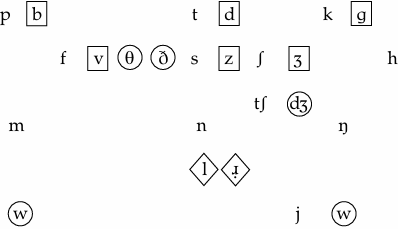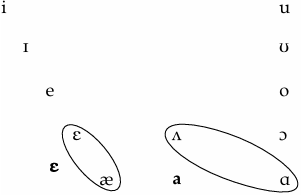
German–English
 المؤلف:
Mehmet Yavas̡
المؤلف:
Mehmet Yavas̡
 المصدر:
Applied English Phonology
المصدر:
Applied English Phonology
 الجزء والصفحة:
P195-C8
الجزء والصفحة:
P195-C8
 2025-03-18
2025-03-18
 697
697
German–English
The overlay of the native phonemes onto the target English inventory reveals the following:

Other German consonants are /χ, ç, ts, pf/.
Missing targets include /θ, ð, ʤ, w/, which are commonly rendered as [s, z, ʧ, v] respectively.
Voiced obstruents /b, d, g, v, z, ʒ/, although shared by the two languages, do present problems in final position, as they are rendered voiceless in German.
Salient phonetic differences, once again, are related to the liquids. The German lateral is ‘clear’, and the r-sound is a uvular fricative. It is also worth mentioning that /ʁ/ is normally an approximant intervocalically; after voiceless obstruents it is voiceless (e.g. trat [tχat] “kicked”); post vocalically before a consonant or word-finally, it is vocalized to [ɐ]. All these variations are sources of the problems learners face when dealing with the target English retroflex approximant /ɹ̣/. It may also be worth mentioning a slightly different phonetic realization of German /j/ in that it is produced with friction.
Vowel mismatches are depicted in the following chart:

Other German vowels are /y, Y, ø, œ, ε:, a:/.
The German tense vowels /i, e, o, u/ are longer but lack the diphthongal characteristics of the ones in English. This presents a slight phonetic mismatch.
German syllable structure, which can be described as (C) (C) (C) V (C) (C) (C), is as complex as that of English, although the specific combinations allowed may not be identical. Thus, any difficulty that may be observed will be due not to the number of consonants but rather to mismatches of the combinations of the types of sounds.
Being stress-timed languages, English and German share many characteristics in stress and rhythm. Thus, these areas are not expected to create problems for learners.
The following summarizes the major trouble spots:
• missing target phonemes: /θ, ð, ʤ, w/;
• distributional restrictions: voiced obstruents;
• salient phonetic differences: liquids;
• insufficient separation of target vowel distinctions.
 الاكثر قراءة في Phonology
الاكثر قراءة في Phonology
 اخر الاخبار
اخر الاخبار
اخبار العتبة العباسية المقدسة


